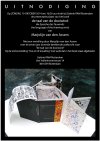- Artists
- RAM artists
- Per Abramsen Karin Arink Marjolijn van den Assem Désirée de Baar Selim Birsel Honoré d'O Luc Deleu Freek Drent Rolf Engelen Wim Gijzen Jeanne van Heeswijk Shelagh Keeley Tamás Komoróczky Libia Castro & Ólafur Ólafsson Bert Loerakker Patrick Merckaert Pieter Laurens Mol Hajnal Németh Zaida Oenema Jaap de Ruig Tomas Schats Josephine Sloet Janos Sugar Hans Verweij Co Westerik Hulya Yilmaz
- Special projects
- Will Alsop Carla Arocha Sannah Belzer Monique Benthin Jurgen Bey Marinus Boezem Berlinde de Bruyckere Belu Simion Fainaru Mirjam Hoekman Richard Hutten IFFR Bruce McLean Leonel Moura Eric de Nie Kas Oosterhuis Jan J Schoonhoven Lydia Schouten John van 't Slot Arjanne van der Spek Kees Touw Ben Vautier Gerard Verdijk Henk Visch Christina de Vos Erwin Wurm
- By invitation
- Gijs Assmann Mari Boeyen Christian Boltanski Imre Bukta Anne van Eck Heide Fasnacht Alain Fleischer Gijs Frieling Arie de Groot Mehmet Güleryüz Dianne Hagen Jan Henderikse Wipke Iwersen Arno Kramer Lada Project Ilona Lénárd Qiangli Liang Mark Luyten Brian Maguire Jean Mauboules Josef Felix Müller Rudolf Pacsika Anne van de Pals Vanessa Jane Phaff Ahmet Polat Patrick Raynaud Miguel Angelo Rocha Cornelius Rogge Marjan Teeuwen Roos Theuws Laure Tixier Kamiel Verschuren Krystyna Ziach
- RAM artists
- Exhibitions
- News
- Shop
- --> RAM
- Search
- Nederlands
News Overview: |
||||
|
27-11-2014
12-11-2014
05-11-2014
20-10-2014
06-10-2014
|
||||
Article
171 till 175 of 302 items :
|
||||
| 2010-02-01 |
| SPACE FOR ALIENATION |
Spaces fascinate Desirée de Baar. These can be lived-in rooms in a house or building, but also specific, tough, masculine rooms such as a prison cell or an observation post. She wants to make these spaces her own. She does this by exaggerating some parts, details so ordinary they escape the notice of others, or by displacing the rooms to a gallery or museum where she transforms their character. Thereby she creates alienation. The viewer has to backtrack. His assumptions are thrown to the wind. His faded imagination is stirred. Worn spots or signs of bygone times can result in a room being hung with wallpaper containing old photos. The view of the past becomes literal. At the same time she has the wallpaper carry on through to inappropriate places – in front of the window or on the floor, for example – thus again casting out the anecdotal and reviving the imagination and interpretation. In addition she sometimes finishes the wallpaper work with hand-drawn patterns. She therefore places the viewer into an environment that on the one hand feels familiar, but on the other hand is so absurd that a feeling of uneasiness or nervous laughter is unavoidable. In her knitted works she either actually knits components of a room – bath tub, washbasin, tap, etc. – and adds lines or drawings to suggest the missing sections, or she knits large sections of the room and then leaves out the specific components. She has constructed a prison cell, for example, almost entirely from wool. In doing this she shatters the common perception of a room like this. What ‘should’ be cold, impersonal and bleak becomes in her hands soft, amiable and tactile. This reversal is intensified by her having knitted it in pink. When she places these works in a gallery or museum, she is adding a dimension of alienation. This is definitely the case, for example, with her latest work, ‘the observation post’. She has reproduced the majority of this by knitting it in white wool, thereby not only totally undermining the suggestion of danger, inherent to such a structure, but also depriving it of its function. While the viewer was able to walk round in the knitted cell and feel the alien material, the observation post cannot be entered. The viewer is only able to look at the object, observe it, whereas its intended function is to observe, to spot dangers. With this Desirée de Baar takes her transformation process a step further. She makes sculptures from her rooms. Desirée de Baar began her career almost exclusively with knitted works. Because the process of making something is of essential importance for her – by degrees it boosts self-confidence in the feasibility of the work – she included this as part of her works, a sort of performance. She no longer does this. She now leaves the completion of her works entirely to the creativity and imaginative powers of the viewer. He can find his own way out of his feeling of alienation. Rob Perrée Amsterdam, January 2010. Translation: Jane Hall |
 |





